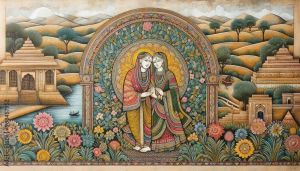Indian subcontinent is known for its rich heritage of fabrics and fabric arts. Since ancient times people of this region used various art forms in their garments and ornaments. The history of handloom spans thousands of years, with tons of variations and gorgeous tapestries.

History Indian fabrics – Indian handlooms
In India weaving with handlooms began for over 5000 years. Archaeological evidences found in the ancient Indus Valley Civilization of Mohenjodaro show that handloom weaving techniques had been part of the civilization. In ancient India, most of the hamlets had a family of weavers and spinners who wove various types of fabrics. These weaving techniques increasingly sophisticated overtime, allowing for more intricate patterns and opening up room for trade. It is a well-known fact that Indian silk fabrics were transported to western world through the Silk Route.
During the 16th to 19th centuries of Mughal reign the Indian handlooms were elevated to the status of art by Mughal emperors. It was during this time that artisans were commissioned to make tapestries illustrating kings’ conquests and stories. Handloom grew beyond a fabric to a medium for narration of Mughal conquests in the history.
Death of Handloom Weaving in British India
The British colonization of Indian subcontinent was the death knell of the handloom industry. As the British colonialists were focused solely on exporting raw cotton from India to the west and importing machine-made fabrics to this country, the demand for hand-woven fabrics drastically declined. These policies put an end to the Indian handloom industry and many skilled artisans moved to unskilled labours for their livelihood.
The Rebirth of Handloom as Khadi during the struggle for Independence
Mahatma Gandhi emphasized the importance of self-reliance to the people of India and as a part of non-co-operation to the British products & imperial powers he started wearing handwoven fabric & urged the country to follow it as a symbol of self reliance. The Charkha and Khadi became symbols of Indian independence. It has been a milestone in the history of handloom in India.
Post Independence, the handloom industry got back up from the government against competition, and it could thrive for a long time. This period witnessed a boom in handloom products, and their usage.
Decline of Handloom industry in modern India
Over time handloom industry faced with challenges in the form of competition from cheaper and faster machine-made fabrics, problems with sourcing natural fibres. Government support also was not sufficient to prevent the death knell of the industry.
A revival to handloom industry in the millennium
With the movement for more sustainable and ethically sourced fashion, it seems that handloom weaving may boom further. Many fashion afficianados have generated interest in handloom fabrics and products recently. For further advancement and progress in this sector there is a dire need of support from people as well as the government.

Various types of Indian Handlooms & textiles
Handloom fabrics have been categorized or named depending on specific use, place of origin, available materials, and technique.
The most common types of handloom (the machine) include pit looms, frame looms, backstrap looms, and fly shuttle looms
Chanderi Handloom Fabric: A lightweight fabric typically made of silk and cotton blends, known for traditional designs such as peacocks, flowers and geometric patterns.
Maheshwari Handloom Fabric: It is mostly made available in bold, vibrant colours and intricate designs and the silk-cotton blend of this technique is airy and lightweight.
Kanchipuram Handloom Fabric: These are well-known for durability and lustre.
Tussar Silk Handloom Fabric: Tussar silk fabric is used in sarees, shawls and clothing items, this fabric has a unique softness and sheen.It is loved by the western people and therefore it is exported to western countries also.
Pochampally Handloom Fabric: It is a unique fabric weaving of Telangana and is famous in most part of the world for its geometric patterns.
Ikat Handloom Fabric: Created by dyeing yarn before weaving, this technique produces bold fabrics.
Patola Handloom Fabric: A Gujrati hand loom type well known for its colourful and intricate designs.
Indian handlooms with its vibrant colours , weaving patterns and fabric art paintings such as kalamkari, madhubani, midhila and pattachitra have enticed the world for many centuries and hope to continue doing the same in an incredible way in the years yet to come.
Trends in Indianheritage Fashion
Pattachitra Painting

Pattachitra arts is a form of fabric painting known for its intricate details as well as mythological narratives and folktales inscribed in it.Pattachitra is one of the ancient artworks of Odisha ,Bengal & Bangladesh. In Sanskrit, the word paṭṭa means “cloth” and chitra means “picture”. Most of these paintings depict stories of Hindu mythology.
Madhubani painting

Madhubani paintings is a popular art form which has been widely used in Indian ethnic fashion for many decades. It is passionately loved by Indian fashion aficionados across the globe and fabrics and outfits with madhubani paintings are in huge demand. This ancient ethnic art originated from Madhubani district of the Mithila region of present Bihar,India.
kalamkari art on fabrics

Kalamkari is an ancient fabric art renowned for its mesmerizing beauty and intricate art work. kalamkari paintings portray deities and scenes taken from the Hindu epics such as Ramayana, Mahabharata and Puranas.